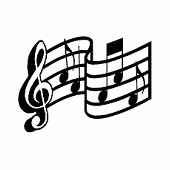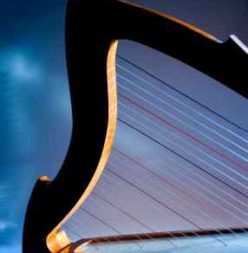 How much music theory do you need to know to play the Celtic harp? Most musicians, including Celtic harpists, find they at least want to know the basics: lines and spaces on the grand staff, as well as the values of quarter, half and eighth notes, as a start. If you’re working with a teacher and/or a good beginning harp book, you’ve been learning basic theory as you go, and you are able to read music enough to play some of the wonderful music published for the Celtic harp.
How much music theory do you need to know to play the Celtic harp? Most musicians, including Celtic harpists, find they at least want to know the basics: lines and spaces on the grand staff, as well as the values of quarter, half and eighth notes, as a start. If you’re working with a teacher and/or a good beginning harp book, you’ve been learning basic theory as you go, and you are able to read music enough to play some of the wonderful music published for the Celtic harp.
Here are some music theory drills to test you on identifying notes, key signatures, intervals and chords. If you want the best comprehensive online theory lessons, complete with tutorials and interactive drills, don’t miss this resource. It’s free to use online, and now they also have a fabulous app, called Tenuto.
At the bottom of this page you’ll find more theory resources, including a free pdf guide to chords on your harp.
Why learn music theory?
You can play the Celtic harp simply by reading the music in front of you, or perhaps by ear, if you’ve got a strong ear. Both methods are useful and necessary. But playing the harp can be a lot more fun than either of those methods alone (or together) would allow if you understand the basics about how music is constructed.
Learning concepts in music theory is like learning how the grammar of another language works. There are basic concepts and rules that, once you understand them, will free you from being limited to following someone else’s music notation! Guitar players have understood this forever.
Oh, it’s easy for guitarists, you might say–the chords are just finger patterns, and when they run out of chords they know, they simply snap on a capo to change the key. Well of course that’s not all there is to it, as any guitarist will tell you. But here’s the good news for Celtic harpists: chords on the harp are “just finger patterns”, too.
The beauty of the lever harp is this: if you set the f-sharps by raising the levers on your f-strings, you now have the key of G, with no further remembering required. In other words, your fingers on the strings make the same shape whether you’re playing a D minor chord, with F in the middle, or a D major chord, with F-sharp in the middle. This means that playing chords on the harp is really, really easy–for example, a third is always two strings with one string open between them.
Lucky? Yes, but this simplicity is a two-edged sword, because it is easy to forget all about what key the harp is tuned in, or to not really understand it, or to simply spend all your time playing just what’s on the sheet music in front of you.
Don’t do that! If you spend a little bit of time with music theory, long enough to understand the chords and their shapes, you can play what you want, in any key. You can play with simplicity, or with jazzy extensions and color notes (even on the lever harp). You can improvise for hours with a simple left-hand vamp, and everyone will think you’re playing something much more complicated (read interesting).
Then take your knowledge of chords, add in some basic rhythm practice and information about style, and you can take those same finger patterns (called “hand forms”) and create rock, blues, Latin, gospel, country, new age . . . whatever music calls to you.
Want to learn more? Use these music theory resources to free that inner musician of yours to improvise, compose, experiment, re-arrange, and therefore express his or her own heart’s song. If you do this, I promise you, you will have a lot more fun!
Basic Music Theory: Building the Chords
If you ever even tried to play guitar, you probably learned that you were all set and ready to go on many, many songs right after you learned the first three chords. Playing the harp can be just as accessible. (See Celtic Harp Tunings) On any lever harp, you have access to 7 keys, plus their relative minors. But for now, learning the chords that are common in the keys of C, G, and F will give you a good start. (Note that each of these major keys has a relative minor; they are Am, Em, and Dm, respectively. Those keys will come in handy later).
Let’s start with C, the “people’s key.” If you build a chord on the first scale degree (the first note of the scale), with your fingers on every other string, you will have the notes c, e, and g. This chord is the “home base” for the key of C, also called the I chord. You can build a chord on each scale degree the same way. For now, just pay attention to two other chords: F (f, a, c), and G (g, b, d). These are the famous IV and V chords. These are the same chords the guitar-player learned. Try harmonizing a simple tune, like Row, Row, Row Your Boat with these chords (in fact, that song requires only two of them).
Here is a PDF file that shows you the chords for each scale, all playable on a Celtic harp tuned in Eb:
building-chords-on-the-scale
And here is a tutorial on how those diatonic chords are built and why they are major, minor or diminished:
Exercise provided by musictheory.net
If you are excited by the possibility of creating your own music, you won’t want to miss this comprehensive sequence of lessons that takes you through music theory with an emphasis on scales, chords and ingenious chord maps for creating your own progressions. Check out Music Theory for Songwriters.

